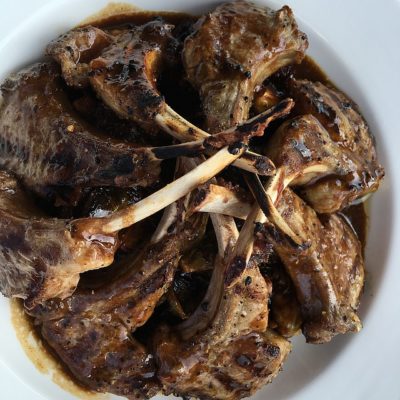 Give a dog a bone, and it is very likely to get somewhat territorial over it. Dogs instinctively love bones, and this is for a multitude of reasons. Raw bones, including Lamb bones, offer dogs activity, nutritional benefits and dental care!
Give a dog a bone, and it is very likely to get somewhat territorial over it. Dogs instinctively love bones, and this is for a multitude of reasons. Raw bones, including Lamb bones, offer dogs activity, nutritional benefits and dental care!
This is not to say there are no dangers of feeding your dog raw bones. Bone chewing can be both beneficial and harmful for them, and a lot of it depends on what kind of bones you feed them, how big they are, and how often you do it.
As a responsible pet owner, you should know the pros and cons of raw bone feeding, and how often it is appropriate. Supervised carefully, your dogs raw bone chewing / consumption can prove to be a great activity that supports their well-being!
First Things First; Never Give Them Cooked Bones!
As a main principle, be sure to never give your dog cooked bones. This includes any type of cooked bone from chicken, turkey, ham, etc. When bones are cooked, their structure changes greatly, and they become harder, making it easier for them to break into pieces and splinter.
The needle-like shards that break off of the cooked bone can cause a great amount of problems for your dog. The broken pieces can get caught in their throat, cut the soft tissue in their throat, and get stuck in their digestive tract. This can lead to uncomfortable issues such as an upset stomach, diarrhea, loss of appetite and even more serious ones such as cutting the lining of their stomach and insides, possibly leading to death.
Benefits Of Raw Bones For Dogs
Starting at a young age, raw bones are a great way to teach your teething puppy what is appropriate to chew, and what is not. The bone will give them more than enough to chew on, and will likely keep them satisfied for awhile.
For dogs of any age, raw bone chewing is an activity that most will enjoy, at least for some period of time.
Ever notice your dog’s stinky breath? Of course you have. Chewing on raw bones proves to be a great factor in assisting their dental health, helping to remove plaque and bacteria that can’t be removed by water and doggy-toothpaste alone. The dental care received from raw bone chewing can help to reduce your dog’s risk of periodontal disease, helping to clean their teeth
and gums. Raw bone chewing, in addition to brushing their teeth, will help to keep their dental health as exceptional as possible. The dental care from raw bone chewing is perhaps its greatest benefit.
Contained within bones are fats, proteins, vitamins and minerals such as Calcium and Phosphorus. In most cases, the bone will be used for chewing, and not whole consumption, so they will not get all of the health benefits contained. But, there is still some health benefits to be consumed through chewing. Even if your dog is consuming a whole raw bone, they should still be receiving their vitamins, minerals and nutrients from other foods in their well-rounded diet.
Advice And Dangers On Raw Bone Chewing / Feeding
As mentioned, never give your dog a cooked bone, as this can lead to many problems for them. If you want to give your dog a bone, always make sure it is raw.
Always, be sure to give your dog a bone that is big enough for them to not be able to swallow, and take it away from them when you believe it is getting small enough for them to swallow. Raw bones are broken down much more easily by your dog, but an abundance can still lead to uncomfortable issues.
Lamb, ham and beef bones are normally the ones that are big enough to be chewed on for a bit before they get too small. Always avoid bones from chicken and turkey, as these are typically smaller and more fragile, breaking into small sharp pieces even more easily.
Bones should be used as an occasional treat, perhaps one to two times every two weeks. Moderation will allow them to see the benefits raw bone chewing offers, while keeping the possible issues at bay.
Always supervise and be involved in your dog’s raw bone chewing! This is to ensure they are chewing it safely, not swallowing big pieces, and to help ease the territorial instincts they may get when they receive a bone.
Raw Lamb Bones Are Good To Go, With Moderation!
As with any treat you wish your dog to receive, always do so in moderation. An excess of anything will hurt anyone, and your dog’s raw bone chewing is no exception. Be sure to never give them cooked bones; supervise their chewing and reaction; and never allow them to chew bones small enough for them to swallow whole. The dental care and fun activity your dog can get out of raw bone chewing is great, so try not to let inattention to detail ruin that!
Sources
“No Bones (or Bone Treats) About It: Reasons Not to Give Your Dog Bones.” U.S. Food and Drug Administration, FDA, www.fda.gov/consumers/consumer-updates/no-bones-or-bone-treats-about-it-reasons-not-give-your-dog-bones.

Hi, I am Andrew. I am the editor at FamilyWithPets. I am enjoy learning and sharing information about pets that helps enrich the lives of pets and pet parents.
